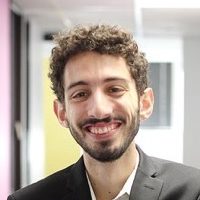The first time Ludmila Page watched “Schindler’s List,” she was unfazed: Having lived out the events in Steven Spielberg’s 1993 Academy Award-winning film, the 96-year-old Holocaust survivor failed to register any shock at the silver screen version.
“I went to hell,” she said. “You know, nothing surprises me.”
A slight woman with short, strawberry blonde hair and bifocals, Page made the 50-mile drive from Beverly Hills to Chapman University in Orange County to be on hand for the opening of an unprecedented new archive dedicated to Oskar Schindler, the man who saved her life and that of her late husband, Leopold.
“I’ve been hearing about this story about Oskar Schindler since I was old enough to understand,” Marie Knecht, Page’s daughter, said, sitting next to her mother in the library maintained by Chapman’s Rodgers Center for Holocaust Education.
Over a banquet dinner on Nov. 10, Chapman President Daniele Struppa announced the opening of the Oskar Schindler Archive, the largest collection of documents related to the German industrialist credited with saving the lives of some 1,200 Jews during World War II.
The documents come as a gift from historian David M. Crowe, whose biography of Schindler, “Oskar Schindler: The Untold Account of His Life, Wartime Activities, and the True Story Behind the List,” is seen as definitive.
In the course of researching the book, Crowe amassed a trove of about 20,000 documents, including photographs, transcripts, architectural drawings and more. Among those are letters between Schindler and the Jews he saved (known as Schindlerjuden or Schindler Jews) and differing versions of his famous list — a roster of Jewish prisoners to be transferred to his factory in the Sudetenland rather than to various death camps.
In searching for a university to house those documents, Crowe settled on Chapman’s Holocaust center because of its commitment to educating a wider public, such as non-Jewish community members and local high school students, he said at the announcement.
After he made his decision and called Marilyn Harran, the Rodgers Center director, she quickly began making arrangements to renovate a room in its library to house the archive. And on Nov. 10 that room — now outfitted with wraparound glass exhibit cases filled with featured documents and two conference tables for researchers — opened to the public.
Now, Chapman faculty and students, along with Holocaust researchers from outside the university, can view any of the archive’s documents by appointment.
The archive constitutes a “living piece of work and not just a depository,” Harran said at the dedication, pointing to how the archive would help advance Holocaust scholarship and spread it to an ever-growing public.
The archive is another feather in the cap of what Harran called a “small but mighty center” that earlier this year accomplished another first in Holocaust education. Through Harran’s work, Chapman became the first institution outside of USC to gain remote access to USC Shoah Foundation’s Visual History Archive, a collection of video testimonies from more than 54,000 survivors of the Holocaust and other genocides. Any member of Chapman’s faculty, staff or student body can now freely view the videos on their own computers.
The center’s distance from Los Angeles’s traditional centers of Jewish community and Holocaust education provides both a challenge and an opportunity: It is far from many resources and prominent institutions in the field of Holocaust scholarship, yet able to reach a public with less exposure to the subject.
In 2011, it raised its profile by landing Elie Wiesel, the renowned Holocaust survivor and author, as a distinguished presidential fellow. Wiesel returned every year until his death in July to meet with students and answer their questions.
At the banquet, Harran said she hopes the Schindler Archive will inspire many more such donations.
“We believe and hope this very significant gift will be the seed for many gifts to come,” she said.
After the dinner, students, faculty and guests gathered in the campus’s nondenominational chapel for an interfaith service in honor of the 78th anniversary of Kristallnacht, which fell the day before the banquet.
Under the soaring ceilings of the Wallace All Faith Chapel, decorated with granite floors and oblong windows set high in the walls, the audience heard the “Schindler’s List” theme performed on violin and piano along with readings from witnesses of 1938’s Kristallnacht, when synagogues across Germany, Austria and the Sudetenland regions of Czechoslovakia were systematically looted and burned.
Crowe took the stage to speak about Schindler, who, despite his affiliation with the Nazi Party, spent his entire fortune bribing officials to keep the Jews employed in his enamelware factory and away from the fires of the Holocaust.
Schindler was “not the type of person you would expect to have done something like this,” Crowe said, pointing to his earlier work as a Nazi spy and his proclivity for “fast cars and women.”
Page, the Schindler Jew who attended the event, acknowledged Schindler’s faults. But for her, they didn’t diminish in the least his heroic actions.
“He had shortcomings like every human being — women, drink,” she said. “But we considered him God.”
Talking softly as she sat, upright, in the Rodgers Center library, she added, “He saved our lives.”























 More news and opinions than at a Shabbat dinner, right in your inbox.
More news and opinions than at a Shabbat dinner, right in your inbox.